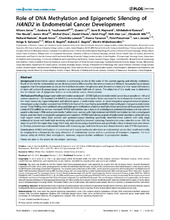| dc.contributor.author | Jones, Allison | en_US |
| dc.contributor.author | Teschendorff, Andrew E. | en_US |
| dc.contributor.author | Li, Quanxi | en_US |
| dc.contributor.author | Hayward, Jane D. | en_US |
| dc.contributor.author | Kannan, Athilakshmi | en_US |
| dc.contributor.author | Mould, Tim | en_US |
| dc.contributor.author | West, James | en_US |
| dc.contributor.author | Zikan, Michal | en_US |
| dc.contributor.author | Cibula, David | en_US |
| dc.contributor.author | Fiegl, Heidi | en_US |
| dc.contributor.author | Lee, Shih-Han | en_US |
| dc.contributor.author | Wik, Elisabeth | en_US |
| dc.contributor.author | Hadwin, Richard | en_US |
| dc.contributor.author | Arora, Rupali | en_US |
| dc.contributor.author | Lemech, Charlotte | en_US |
| dc.contributor.author | Turunen, Henna | en_US |
| dc.contributor.author | Pakarinen, Päivi | en_US |
| dc.contributor.author | Jacobs, Ian J. | en_US |
| dc.contributor.author | Salvesen, Helga Birgitte | en_US |
| dc.contributor.author | Bagchi, Milan K. | en_US |
| dc.contributor.author | Bagchi, Indrani C. | en_US |
| dc.contributor.author | Widschwendter, Martin | en_US |
| dc.date.accessioned | 2016-08-04T13:16:24Z | |
| dc.date.available | 2016-08-04T13:16:24Z | |
| dc.date.issued | 2013-11-12 | |
| dc.Published | PLoS Medicine 2013, 10(11):e1001551 | eng |
| dc.identifier.issn | 1549-1676 | |
| dc.identifier.uri | https://hdl.handle.net/1956/12447 | |
| dc.description.abstract | Background: Endometrial cancer incidence is continuing to rise in the wake of the current ageing and obesity epidemics. Much of the risk for endometrial cancer development is influenced by the environment and lifestyle. Accumulating evidence suggests that the epigenome serves as the interface between the genome and the environment and that hypermethylation of stem cell polycomb group target genes is an epigenetic hallmark of cancer. The objective of this study was to determine the functional role of epigenetic factors in endometrial cancer development. Methods and Findings: Epigenome-wide methylation analysis of >27,000 CpG sites in endometrial cancer tissue samples (n = 64) and control samples (n = 23) revealed that HAND2 (a gene encoding a transcription factor expressed in the endometrial stroma) is one of the most commonly hypermethylated and silenced genes in endometrial cancer. A novel integrative epigenome-transcriptome-interactome analysis further revealed that HAND2 is the hub of the most highly ranked differential methylation hotspot in endometrial cancer. These findings were validated using candidate gene methylation analysis in multiple clinical sample sets of tissue samples from a total of 272 additional women. Increased HAND2 methylation was a feature of premalignant endometrial lesions and was seen to parallel a decrease in RNA and protein levels. Furthermore, women with high endometrial HAND2 methylation in their premalignant lesions were less likely to respond to progesterone treatment. HAND2 methylation analysis of endometrial secretions collected using high vaginal swabs taken from women with postmenopausal bleeding specifically identified those patients with early stage endometrial cancer with both high sensitivity and high specificity (receiver operating characteristics area under the curve = 0.91 for stage 1A and 0.97 for higher than stage 1A). Finally, mice harbouring a Hand2 knock-out specifically in their endometrium were shown to develop precancerous endometrial lesions with increasing age, and these lesions also demonstrated a lack of PTEN expression. Conclusions: HAND2 methylation is a common and crucial molecular alteration in endometrial cancer that could potentially be employed as a biomarker for early detection of endometrial cancer and as a predictor of treatment response. The true clinical utility of HAND2 DNA methylation, however, requires further validation in prospective studies. | en_US |
| dc.language.iso | eng | eng |
| dc.publisher | PLoS | eng |
| dc.rights | Attribution CC BY | eng |
| dc.rights.uri | http://creativecommons.org/licenses/by/3.0/ | eng |
| dc.title | Role of DNA methylation and epigenetic silencing of HAND2 in endometrial cancer development | en_US |
| dc.type | Peer reviewed | |
| dc.type | Journal article | |
| dc.date.updated | 2016-04-08T08:17:29Z | |
| dc.description.version | publishedVersion | en_US |
| dc.rights.holder | Copyright 2013 Jones et al. | |
| dc.identifier.doi | https://doi.org/10.1371/journal.pmed.1001551 | |
| dc.identifier.cristin | 1101363 | |
| dc.relation.project | Norges forskningsråd: 223250 | |
| dc.relation.project | Norges forskningsråd: 193373 | |
| dc.relation.project | Norges forskningsråd: 205404 | |
| dc.subject.nsi | VDP::Medisinske fag: 700::Klinisk medisinske fag: 750::Gynekologi og obstetrikk: 756 | |
| dc.subject.nsi | VDP::Midical sciences: 700::Clinical medical sciences: 750::Gynaecology and obstetrics: 756 | |
| dc.subject.nsi | VDP::Medisinske fag: 700::Basale medisinske, odontologiske og veterinærmedisinske fag: 710::Medisinsk genetikk: 714 | |
| dc.subject.nsi | VDP::Midical sciences: 700::Basic medical, dental and veterinary sciences: 710::Medical genetics: 714 | |
| dc.subject.nsi | VDP::Medisinske fag: 700::Klinisk medisinske fag: 750::Onkologi: 762 | |
| dc.subject.nsi | VDP::Midical sciences: 700::Clinical medical sciences: 750::Oncology: 762 | |

